Hare Krsna temples and other projects in Guyana, South
America, are gradually opening like petals of a lotus to
display the full beauty and attractiveness of Lord Krsna .
America, are gradually opening like petals of a lotus to
display the full beauty and attractiveness of Lord Krsna .
In July of 2005, the Hare Krsna devotees of Guyana, South America, would celebrate their first Jagannatha Ratha-yatra festival in eighteen years. Guyanese devotees living in our community of New Raman Reti Dhama in Alachua, Florida, were encouraging everyone to visit Guyana for the festival.
My wife, Yauvanananda Dasi, and I didn't need much convincing. For a long time my wife had wanted to return to visit Guyana, the land where she was born. I had heard many stories about the extraordinary hospitality of the Guyanese Vaisnavas, and my friendship with Guyanese devotees living in Florida made me want to meet more of these kindhearted, godly souls.
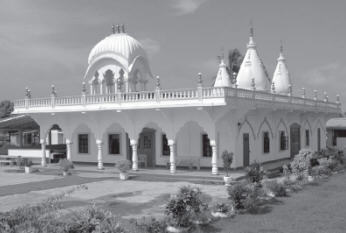
To prepare for our trip, I did some research. The country of Guyana is situated on the Caribbean coast of South America, nestled between Venezuela to the west, Suriname to the east, and enormous Brazil to the south. It is roughly the size of the United Kingdom, with a population of less than 700,000. Over ninety percent of the people live along the coast, the interior of the country for the most part being dense, tropical jungle. It is the only English-speaking country in South America. Since gaining its independence from Great Britain in 1966, the country has been through periods of harsh economic and social upheaval. During the 1980s in particular, many thousands of people emigrated from Guyana to look for a better life elsewhere. Over 300,000 Guyanese now live the United States.
One might ask, why go to a place that so many people are leaving? By material calculation, it would seem undesirable. A Vaisnava, however, has a different set of criteria for making travel plans. Will I please the Supreme Personality of Godhead by going there? Will there be some service I can do for the Lord and his devotees? Can I obtain the association of saintly persons fixed on the path of devotional service? Could I be of some assistance to devotees spreading Krsna consciousness in that place? By all indications, these purposes would be well served by attending the Jagannatha Ratha-yatra festival in Williamsburg, Guyana.
Furthermore, the Supreme Lord Krsna, in his enchanting form of Lord Jagannarha, would be riding the public roads, with his loving devotees surrounding his chariot in a grand parade of chanting and dancing.
Besides, our visit would be in relative comfort. We'd be visiting several temples already established in Guyana by the International Society for Krishna Consciousness. Beginning in the early 1970s, Hare Krsna devotees had done the hard work of spreading Krsna consciousness under the most austere of circumstances. His Holiness Hrdayananda Goswami and Mahavira Dasa were two of the first disciples of Srila Prabhupada to visit Guyana. Later, Bhutadi Dasa, one of Srila Prabhupada's first Guyanese disciples, pioneered systematic book distribution and other programs to bring Krsna consciousness to Guyana. In 1981, His Holiness Satsvarupa Dasa Goswami conducted the first initiations of disciples there. With the arrival of Agrani Dasa from the United States in the 1980s, the presentation of Krsna consciousness to the public took on a new dimension. There were tent programs in cities and towns all over the country, featuring talks, theatre, and slide shows depicting various aspects of Vaisrnava philosophy, as well as the distribution of sanctified vegetarian food offered to Krsna. Later on, Candravali Devi Dasi, a Guyanese lady who joined ISKCON after attending one of the tent programs, inspired many people through her spiritual qualities to take to Krsna consciousness.
REMINDERS OF INDIA
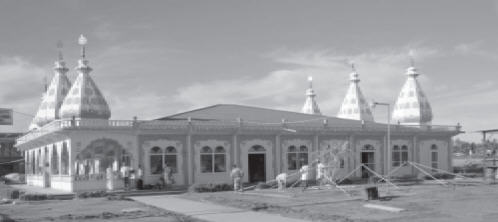
Our airline flight took us from Orlando, Florida, to Miami, and then across the Caribbean Sea to Georgetown, Guyana. The small Georgetown airport was only recently upgraded to accept larger planes. We arrived almost two hours late, but waiting patiently for us was Tridandi Goswami Dasa, temple president of the Sri Sri Gaura Nitai Asirvada Mandir. Tridani saw to every arrangement for our lodging and travel. Practically speaking, everything was taken care of before we could even ask.
Over the next few days I saw many reminders of India: herds of cows on the roads, rice paddy fields, forests of coconut palms, and people of Asian Indian decent going about their business everywhere. The British brought the first Indian immigrants to Guyana as indentured servants to work on the expansive sugar plantations. They were replacements for slave labour, slavery having been abolished in 1834. I mused that some Indians, having survived the grueling three-month voyage, must have seen the Guyanese coastline with its palm and fruit trees and suspected their ship's captain of playing a weird practical joke by bringing them right back to India.
We arrived two weeks before Jagannatha Ratha-yatra, and in the time leading up to the festival we visited three ISKCON temples: Sri Sri Gaura Nitai Asirvada Mandir on Old Crane Road, the Essequibo temple, and Sri Sri Radha Gokulacandra Mandir in Williamsburg. Everywhere the devotees were thoughtful and accommodating. At the temple on Old Crane Road, we were given the very best lodging available, normally reserved for dignitaries and temple leaders. In Essequibo, we stayed with a family who moved downstairs so that we could have the comforts of the better upstairs rooms. At the temple in Williamsburg, we were lodged in the comfortable home of a doctor who was out of town but wanted his house to be used for the care of visitors. Every conceivable kindness was showered upon us.
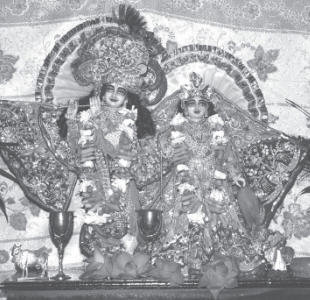
We were joined by Adi Karta Dasa, a senior Prabhupada disciple and British national now living in Florida, and Rajaqi Dasa, a devotee from Trinidad who teaches Krsna consciousness all over the Caribbean. Rajarsi, the pioneer in exposing the Guyanese to Krsna consciousness thtough television, arranged a half-dozen television programs for us to speak about Lord Jagannatha.
Television is the way to reach a wide audience in Guyana. As recently as fifteen years ago there were no televisions there. Now television antennas are ubiquitous, satellite dishes are becoming more common, and a number of government- licensed television stations have sprung up across the country. Unlike the United States, where powerful corporations tightly control the so-called public airwaves, television is very accessible in Guyana. A thirty-second advertisement slot on a station whose signal reaches most of the country costs only US$1.50, and the station managers are always looking for interesting material to broadcast. Consequently, Rajarsi arranged for many thirty-second advertisements about Jagannatha Ratha-yatra to run on television in the days leading up to the festival.
I was traveling with some Deity forms of Krsna I worship every day. When a devotee named Suratanatha found out, he brought me some lotuses to offer them. I was puzzled, however, because the lotuses were closed. Suratanatha just laughed and showed me how to open a lotus before offering it. He explained that there are many kinds of lotuses in Guyana. Some are open, some closed. There are white ones and pink ones, and a very lightly colored pink one that is highly prized.
As I travelled to the temples in Guyana, meeting devotees, seeing their dedication to spreading Krsna consciousness, and experiencing how receptive the people are to it, the example of the lotus kept appearing in my mind. The demeanour of the Guyanese devotees is as attractive as a lotus, and the temples and other projects are gradually opening like petals of a lotus to display the full beauty and attractiveness of Krsna, the Supreme Personality of Godhead.
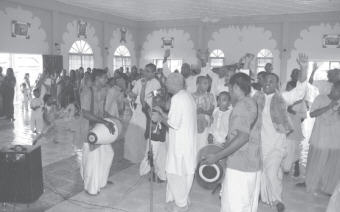
On the first public-chanting procession I attended, I was amazed at the eagerness of people to give donations and get some prasadam sweets and spiritual books. The typical Guyanese house is built in two stories; the first floor is for the kitchen and storage, and the second floor has the bedrooms and formal rooms. Some of these homes are little more than wooden shacks on stilts, but a few are very spacious and opulent. Practically all of them have a fenced-in yard and a gated entrance. The book distributors accompanying the chanting party approached each gate, announcing their presence by calling out, "Inside!" Oftentimes, the homeowners would already be waiting at the gate with money in hand.
In the last few days before the Ratha-yatra, an advance team of devotees visited homes along the toute to give residents a chance to invite a chanting parry inside the gate, where each family could of fer refreshments to the chanters and listen to a short talk about the glories of Lord Caitanya's movement. So many families came forward to do this that the chanting parry was srapping at practically every other house on the street.
Somehow, in spite of the centuries of hardship and isolation the Indian expatriates have endured, separated from Mother India by thousands of miles, vestiges of Vedic culture can still be found. As we walked, I noticed holy Tulasi plants growing wild along the road, and at some of the houses Tulasi was being cared for and even worshipped. Once, we stopped at a Hindu temple, which we entered with loud chanting of the Hare Krsna maha-mantra. The devotees offered respects to the numerous demigods there, knowing them to be empowered servitors of Lord Krsna. Along the way, I saw names such as "Arjune" on roads ide billboards. Indeed, the name of the President of Guyana is Bharrat Jagdeo, invoking remembrance of the name of Maharaja Bharata, son of Lord Rsabhadeva, for whom this planet earth is named Bharat-varsa in the Vedic literature.
SEARCHING FOR GOLD BUT FINDING POISON
In many respects, however, Guyana is afflicted by the ignorance and miseries of Kali-yuga, the present age of quarrel and hypocrisy. One of its most popular export products is rum, and I saw numerous signs announcing "Rum Shoppe." Early Indian immigrants were sometimes lured to Guyana by the prospect of discovering El Dorado, the fabled city of gold that Spanish conquistadors had searched for throughout the Americas. Now there is a brand of rum by the same name, bringing suffering to the local population in the form of alcoholism and related social ills. For the Guyanese, the fabled gold of El Dorado has turned into a real poison.
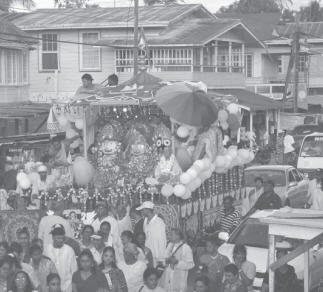
And then there is the matter of race relations. There are longstanding tensions between the Asian Indians and black people, dating back to the complete disenfranchisement of slaves by their former colonial captors when they were replaced on the plantations by indentured servants from India. Ever since Guyana gained independence, there has been a see-saw struggle between the two groups for control of the national government, and elections have sometimes been marred by street violence.
The Guyanese devotees, therefore, are anxious to bring the transcendental science of Krsna consciousness to all segments of society to alleviate the suffering that results from misidentifying the self with the material body. For example, they're establishing a center at the university to the capital city of Georgetown. I could just imagine the sensation it would cause to see black and Asian Indian university students happily chanting the Hare Krsna maha-mantra together.
The devotees of the Lord know the secret to real and lasting friendship- befriending Lord Krsna and singing his holy names with love and devotion. As Srila Prabhupada says in his essay "The Real Peace Formula":
We are searching for a friend to give us peace and tranquility, and that friend is Krsna, God. If we would just make friends with him, we will find that everyone is our friend. God is situated in everyone's heart, and if we make friends with him, he will dictate from within so that we will be treated in a friendly way. If we make friends with the police commissioner, we will receive some advantages, or if we make friends with the president, so many people will be our friend. Similarly, if we make friends with God, everyone will be our friend. If everyone understands that God is everyone's friend and that he is the supreme proprietor, the world will become peaceful. This is the verdict of Lord Caitanya.
FESTIVAL DAY
As the day of the Ratha-yatra festival approached, the devotees' excitement steadily grew. Devotees arrived from neighboring countries such as Trinidad and Suriname, and the ISKCON temple in Williamsburg was buzzing with activity. There were countless flower garlands to make, a festival chariot to decorate, and lots of cooking to be done in anticipation of the throngs of visitors to the festival site.
On the day of the festival, devotees spoke during the morning class about the importance of Jagannatha Ratha-yatra. On this special day, the Lord of the universe comes out of his home to give blessings to everyone as he passes a long the public roads. Because devotees know this, their yearning to see that all people are blessed by coming in contact with Lord Krsna increases to a fever pitch , and they pour their hearts and souls into chanting the Hare Krsna maha-mantra as the Lord takes his chariot ride.
The five-mile Ratha-yatra procession began at 3:00 in the aftern oon. The parade route took us along the main coastal road, ending at the ISKCON temple in Williamsburg. The chariot was cleverly designed to allow the canopy to be collapsed using a hand crank, so that the car could pass beneath electrical lines . As the chariot rolled a long, pulled by dozens of devotees holding two ropes, exuberant chanting of the Hare Krsna maha-mantra could be heard from groups of devotees in front and behind. All the while, various offerings of food and refreshments were made to Lord Jagannatha and then distributed to the crowd.
In the bustling town of Rosehall, people stopped in their automobiles and came out of homes and stores to see the procession. Devotees distributed hundreds of invitation al flyers, and many people followed the chariot back to the temple for the evening's festivities. There they heard devotees such as Narada Rsi Dasa and Rajarsi Dasa speak about the pastimes of Lord Jagannatha, they ate sumptuous vegetarian food offered to Lord Krsna , they joined in the congregational chanting of Krsna's holy names, and they were entertained by Vaisnava youth who depicted how Lord Jagannatha appeared in this world long ago. The countless hours of planning and preparation had paid off in a big way, with thousands of people receiving spiritual benefit.
The day after the festival, I spent an afternoon with some of the older devotees, including Paramatma Dasa, Haridasa Dasa and others, who described the history of Krsna consciousness in Guyana. They recalled the spartan conditions of the early temples, which sometimes were barely more than thatched huts on the banks of a river. They fondly recalled how those simple circumstances brought them close together and made them spiritually strong. In particular, they remembered the efforts of Agrani Dasa, who organized many programs for spreading Krsna consciousness in a big way. It was clear from these talks that the devotees wanted to see a revival of the intensive outreach efforts of the 1980s.
After many hugs from our new Guyanese friends and repeated assurances that we would return, we caught our flight back to the United States on the following day. The warm and welcoming mood of the Hare Krsna devotees of Guyana has remained on my mind ever since my visit there. By Krsna's grace, I hope I will be able to go back again soon.
Panca Tattva Dasa jain ISKCON in 1978, his wife in 1980. Their daughter, Saranagati, serves in the customer service department of BTG and Krishna.com.
